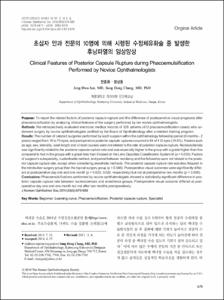초심자 안과 전문의 10명에 의해 시행된 수정체유화술 중 발생한 후낭파열의 임상양상
- Keimyung Author(s)
- Jun, Jong Hwa; Chang, Sung Dong
- Department
- Dept. of Ophthalmology (안과학)
- Journal Title
- 대한안과학회지
- Issued Date
- 2014
- Volume
- 55
- Issue
- 5
- Abstract
- Purpose: To report the related factors of posterior capsule rupture and the difference of postoperative visual prognosis after phacoemulsification by analyzing clinical features of the surgery performed by ten novice ophthalmologists.
Methods: We retrospectively evaluated electronic medical records of 326 patients (412 phacoemulsification cases) who underwent surgery by novice ophthalmologists certified by the Board of Ophthalmology after a resident training program.
Results: The number of cataract surgeries performed by each surgeon within the ophthalmology fellowship period (6 months - 2years) ranged from 16 to 75 eyes, and perioperative posterior capsule ruptures occurred in 64 of 412 eyes (15.5%). Factors such as age, sex, laterality, axial length and clinical courses were not related to the rate of posterior capsule rupture. Nucleosclerosis was significantly related to the posterior capsule rupture rate and was especially higher in the group with a grade higher than five compared to that in the groups with a grade less than 5 based on the Lens Opacities Classification System III (p = 0.033). Factors of surgeon’s subspecialty, nucleofractis method, and period between residency and the fellowship were not related to the posterior capsule rupture rate, except when considering anesthetic methods. The posterior capsule rupture rate was less frequent in the retrobulbar surgery group than the topical surgery group (p = 0.046). Postoperative visual outcomes were significantly different at postoperative day one and one month (p = 0.023, 0.022, respectively) but not at postoperative two months (p = 0.059).
Conclusions: Phacoemulsifications performed by novice ophthalmologists showed a statistically significant difference in posterior capsule rupture rate between nucleosclerosis and anesthesia groups. Postoperative visual outcome differed at postoperative day one and one month but not after two months postoperatively.
목적: 10명의 초심자 안과 전문의에 의해 시행된 수정체유화술의 임상양상을 비교 분석하여 초심자의 수정체유화술 시행 시 후낭파열과 관련된 인자 및 술 후 시력예후의 차이에 대해 알아보고자 한다.
대상과 방법: 전공의 수련과정을 마치고 전문의를 취득한 안과의사가 전임의 과정 중 시행한 수정체유화술 326명의 412증례를 후향적으로 분석하였다.
결과: 각 전문의가 6개월-2년간의 전임의 기간 중 시행한 증례는 16-75안으로 다양하였고 후낭파열은 총 412안 중 64안에서 발생하였다(15.5%). 나이, 성별, 좌우 방향, 안축장 및 입원/외래 여부는 모두 후낭파열의 빈도와 관련이 없었으며 핵경도는 Lens Opacities Classification System III기준, 등급 5 이상인 군에서 그 이하인 군에 비해 통계학적으로 유의하게 후낭파열의 빈도가 높았다(p=0.033). 세부 전문의 분야, 핵분할법, 전임의 이전 수술의 공백여부 또한 후낭파열의 빈도와 관련이 없었으나 구후마취하에 수술한 군에서 점안마취하 수술군보다 후낭파열의 빈도가 낮았다(p=0.46). 술 후 시력예후는 술 후 1일째와 1개월째는 각 술자 간에 유의한 차이를 보였으나(p=0.023, 0.022), 술 후 2개월 이상 경과관찰 시는 유의한 차이가 없었다(p=0.059).
결론: 초심자 전문의에 의해 시행된 수정체유화술의 경우 후낭파열의 빈도는 점안마취하 수술 증례와 술 전 핵경도가 높은 증례에서 유의하게 높으며 술 후 환자의 시력예후는 술자에 따라 수술 직후부터 1개월 내에 유의한 차이를 보인다.
- Alternative Title
- Clinical Features of Posterior Capsule Rupture during Phacoemulsification Performed by Novice Ophthalmologists
- Publisher
- School of Medicine
- Citation
- 전종화 and 장성동. (2014). 초심자 안과 전문의 10명에 의해 시행된 수정체유화술 중 발생한 후낭파열의 임상양상. 대한안과학회지, 55(5), 679–685. doi: 10.3341/jkos.2014.55.5.679
- Type
- Article
- ISSN
- 0378-6471
- Appears in Collections:
- 1. School of Medicine (의과대학) > Dept. of Ophthalmology (안과학)
- 파일 목록
-
-
Download
 oak-bbb-02693.pdf
기타 데이터 / 763.21 kB / Adobe PDF
oak-bbb-02693.pdf
기타 데이터 / 763.21 kB / Adobe PDF
-
Items in Repository are protected by copyright, with all rights reserved, unless otherwise indicated.